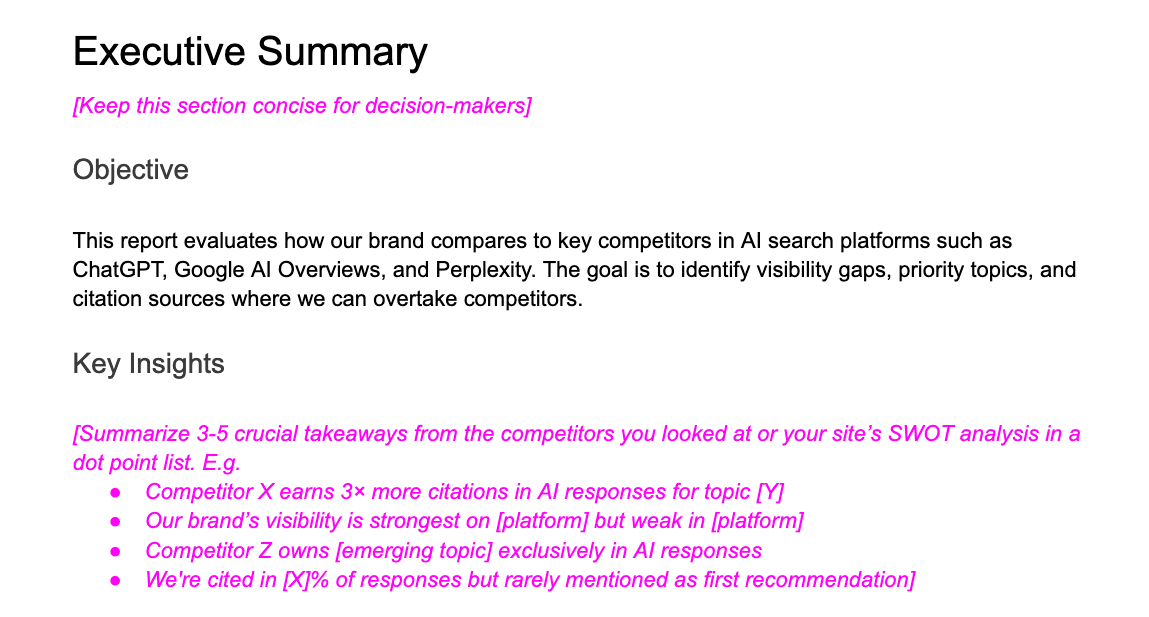If a competitor is mentioned more often, cited more frequently, or framed more favorably in AI answers, they win attention and trust before searchers even know you exist.
This guide shows you how to run an AI search competitor analysis that reveals:
- Which brands in your industry dominate AI search today
- Where your competitors earn visibility, but you don’t
- Which topics, pages, and sources drive their advantage
- What to prioritize to close the gap fast
It’s a step-by-step process you can repeat quarterly, or whenever a new competitor, model update, or internal priority change (such as when you launch a new product) hits your radar.
Want to turn this analysis into a report for stakeholders?
Download the AI Search Competitor Analysis Report Template, a ready-made framework to document visibility gaps, ranking strength, and where your competitors are winning in AI search.
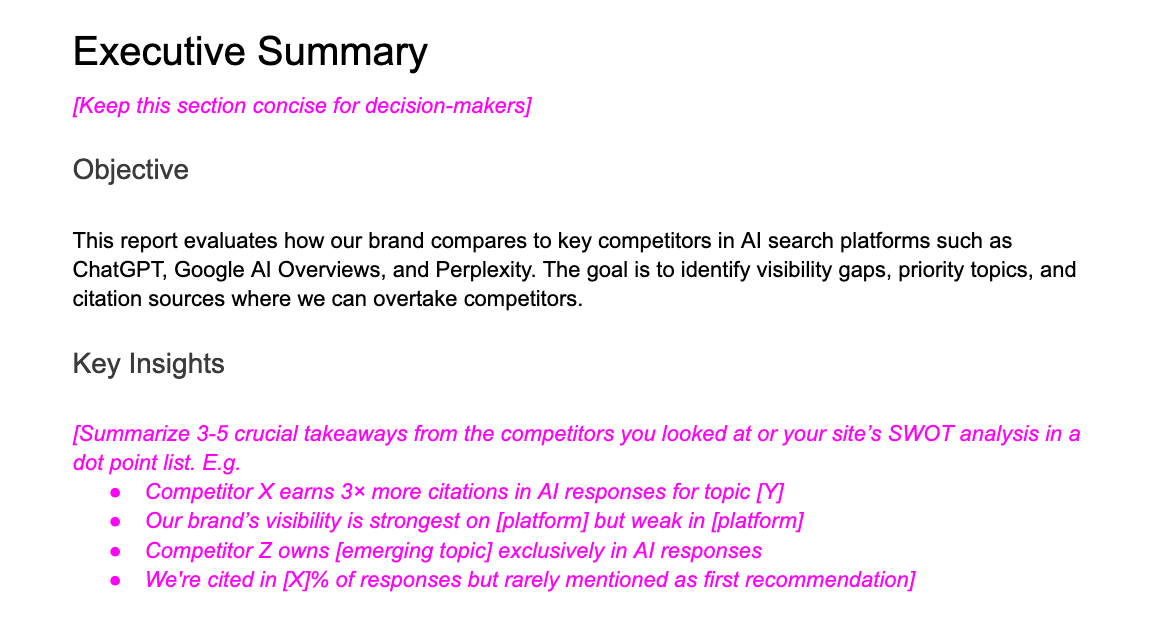
It includes:
- A competitor SWOT analysis for AI visibility
- A topic gap matrix to show who owns which themes
- An action plan section with priority ratings for stakeholders
Use the step-by-step process in this guide to fill it in with real insights and turn raw data into a clear plan your team can act on.
Brand Radar. For instance, if you enter your brand, you can use the AI suggest feature to list other similar brands to yours:

These will typically be competitors you’re aware of and that you compete with for brand mentions in AI responses.
If you check out the Search queries report, you’ll be able to find the competitors that your audience frequently compares you to. You can filter the data by looking for queries that contain your brand and words with comparative intent, like “vs”:
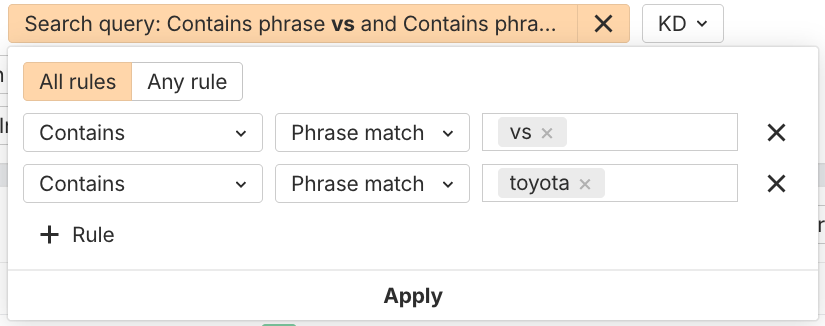
For example, Honda is a strong competitor of Toyota’s that searchers frequently compare:

Other brands that are commonly compared to Toyota include Nissan, Mazda, Ford, Lexus, Suzuki, and Subaru:
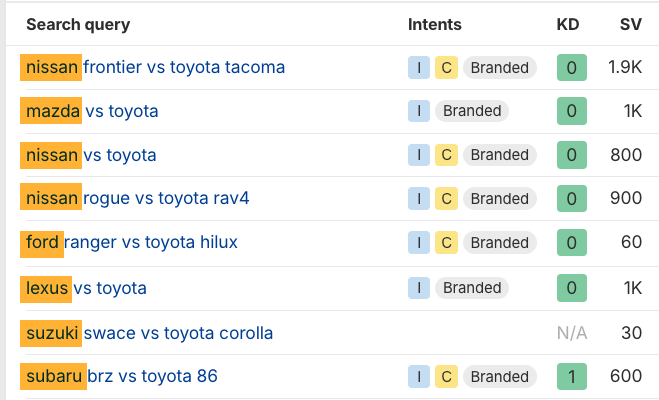
To find competitors that are cited as sources, check out the Cited domains report.
More often than not, you’ll see general sites like Wikipedia, Reddit, or social media in the top spots. These sites are too large and authoritative to compare against in most cases.
But you’ll also spot other sites in your industry that get cited more than your brand. Sometimes they’ll be industry publications. Other times, they’ll be direct competitors, like Ford, Nissan, and Honda, in the example below:
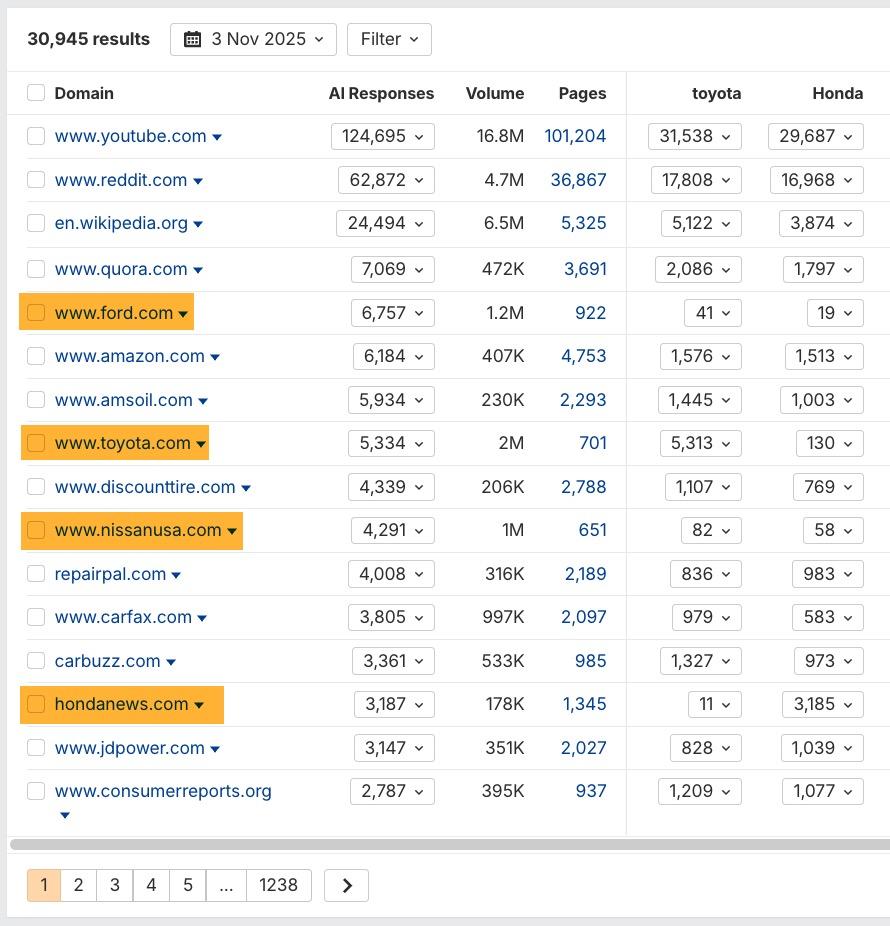
Select the ones that make the most sense for your analysis or that your stakeholders care about the most.
AI Content Helper can help with this. It analyzes your content as you type, allowing you to cover essential gaps.
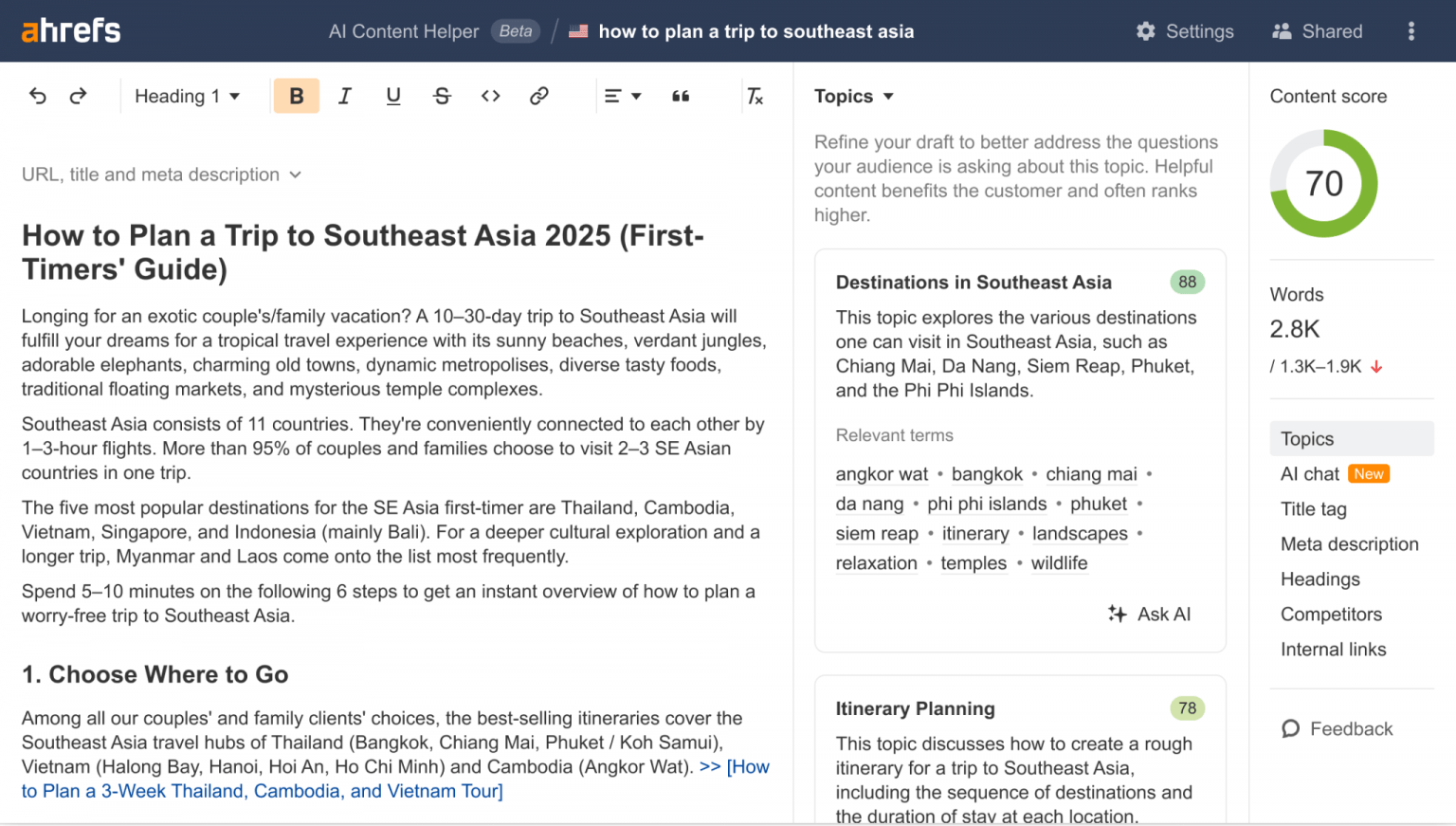
strong factor that influences visibility in AI responses.
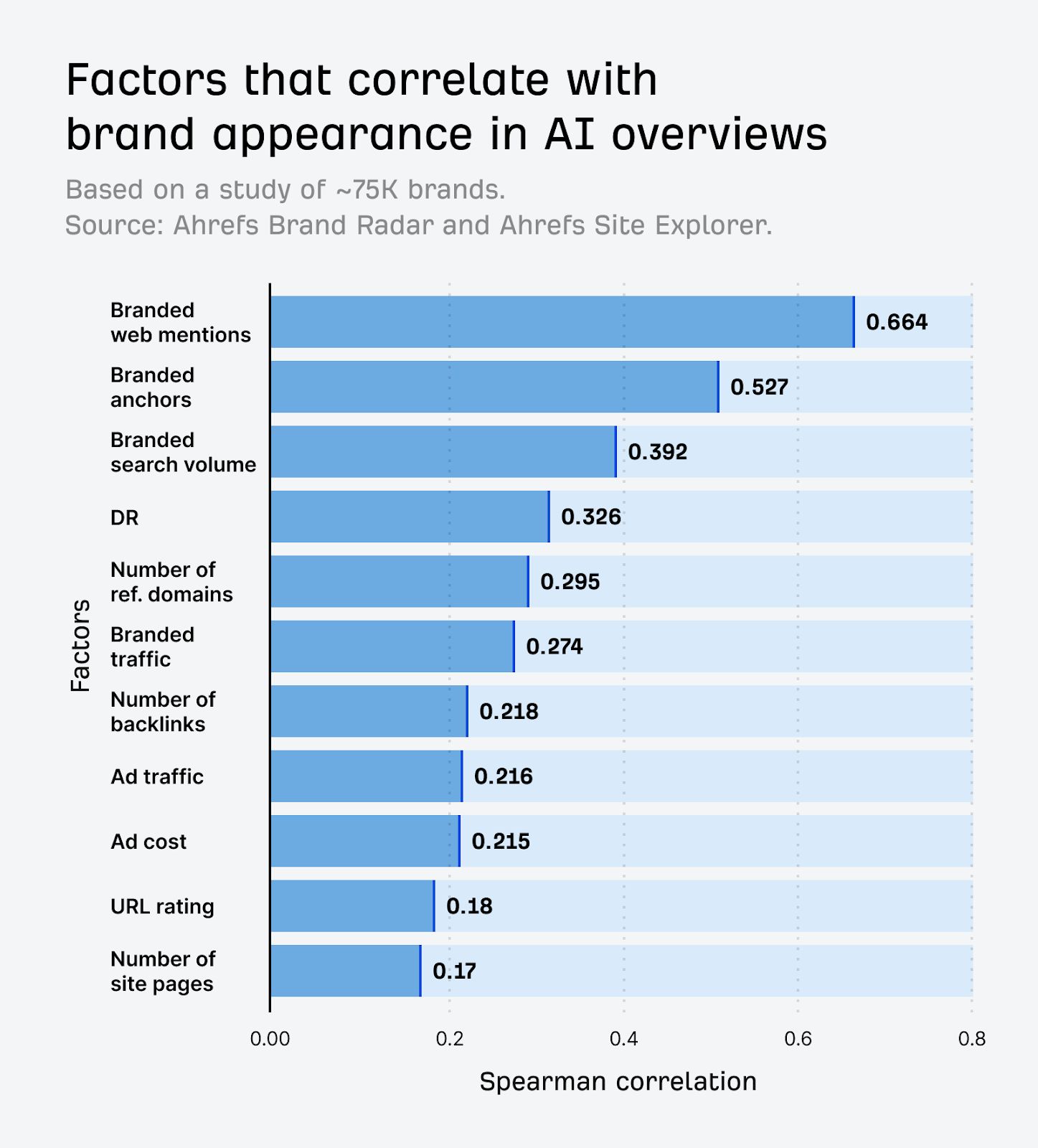
More often than not, AI will cite someone else’s content (even for queries about your brand) than yours.
So, it’s worth checking which sources influence information about your brand and competitors. In Brand Radar, you can check out the Web pages report to find all mentions of any brand online.
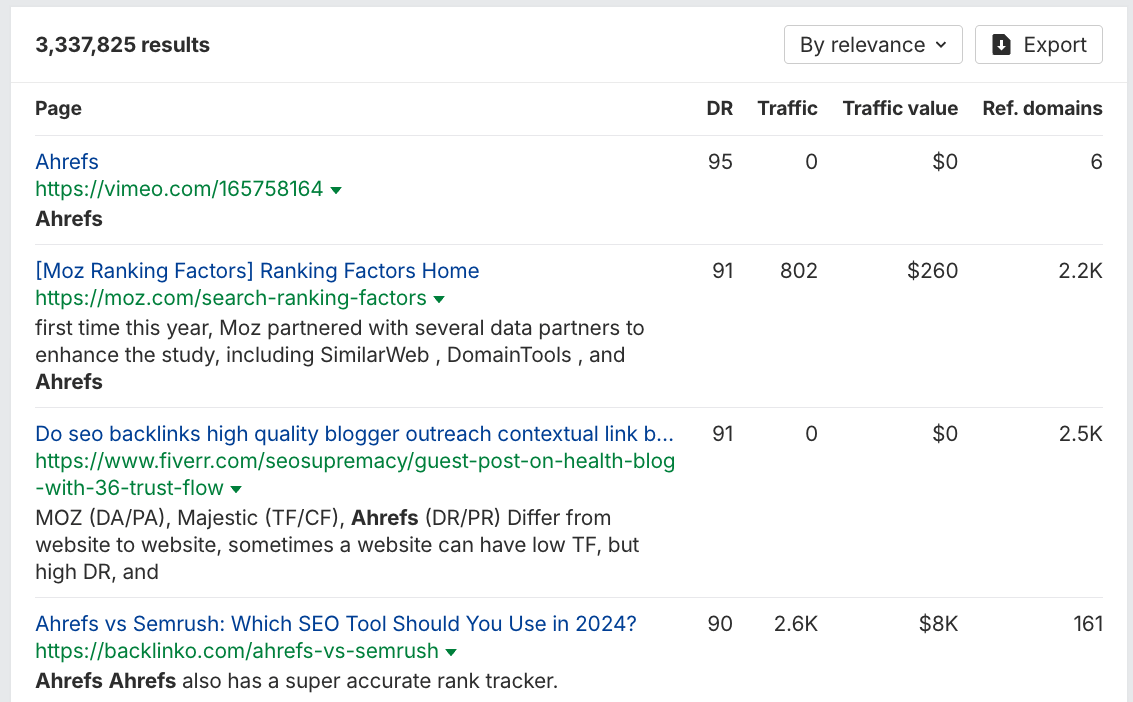
To find gaps in web mentions, I like to search each competitor individually in the main search bar.

Then I use the filters in the Web pages report to remove mentions on their own websites and then export the results.

For instance, you can use “-site:yourcompetitor.com” to remove a competitor’s brand mentions on their own website.
Once you’ve removed irrelevant results, export the list so you can compare it against your brand and other competitors in a spreadsheet. Try out this simple template. Add your exported data to columns B–H, ensuring they are aligned correctly. Then manually fill in the brand in column A.
Keep adding each brand’s export to the bottom of the list.
Once you’ve added data for a few brands, here’s what the comparison view will look like:
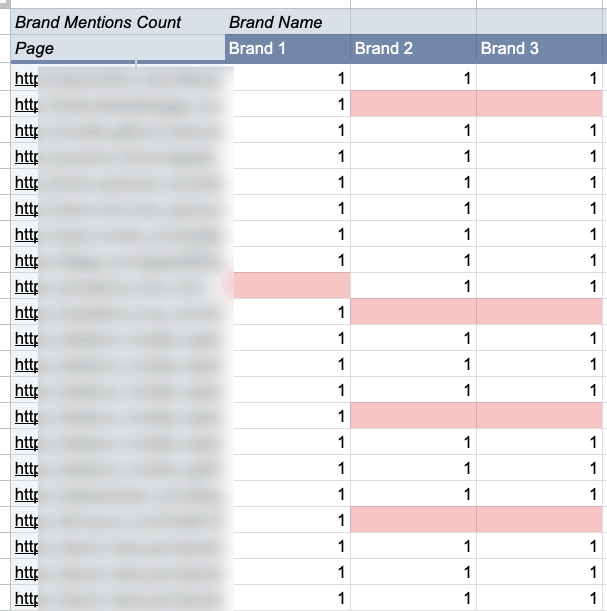
The empty cells point to missed opportunities. Start by scanning for posts or responses that highlight several competitors but leave your brand out; these are likely your fastest wins.
Next, analyze how your competitors earned their most impactful mentions:
- Content types: Are their mentions embedded in blog posts, research reports, or case studies? These formats might be worth replicating or targeting in your outreach efforts.
- Publications and sources: Are the same authors or websites referencing them consistently? If so, they may be trusted voices in your space and suitable candidates for outreach or collaboration.
- Campaign triggers: Was the mention associated with a product release, viral post, or a unique framework? Identify what sparked the attention to guide your own strategic moves.
- Distribution tactics: Guest articles, joint content, or partner campaigns might be amplifying their presence.
Reverse engineering what’s working for your competitors helps you close visibility gaps, understand which tactics actually move the needle in your category, and how to make them work for your brand.
AI Search Competitor Analysis Report template if you don’t already have one.
Replace all the pink sections and summarize your key findings in scorecards and quick snapshots of key points.
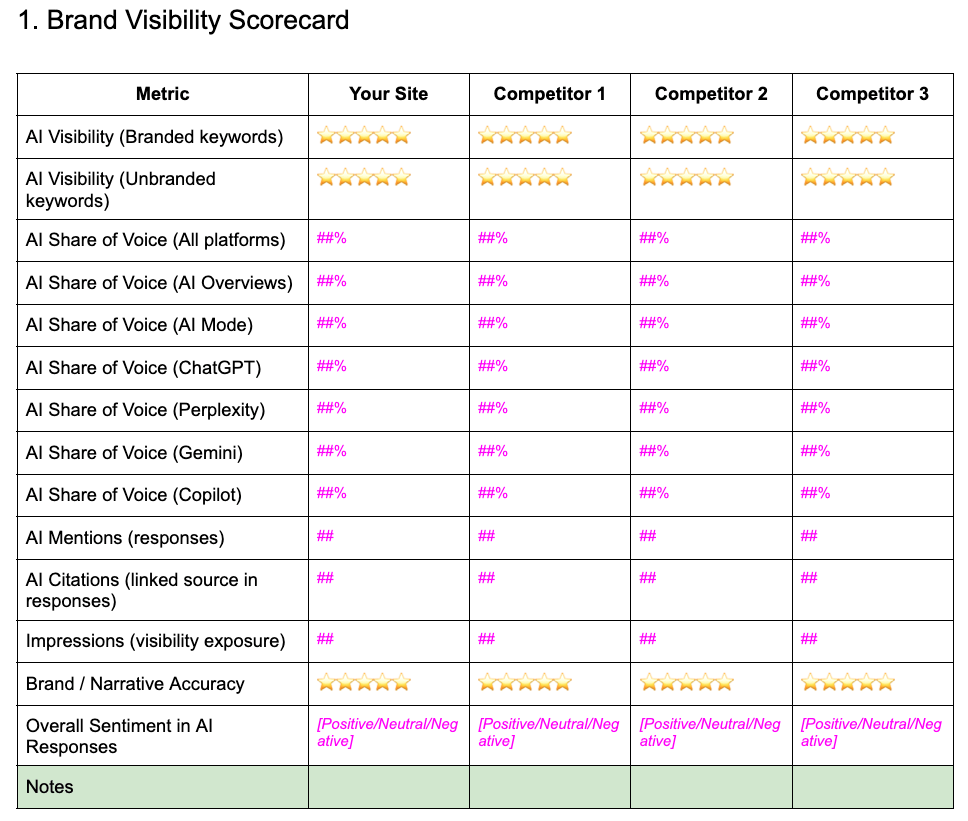
Also, it’s worth making competitor tracking a recurring workflow.
Run the same analysis monthly or quarterly to measure how share of voice and brand framing evolve across AI models and markets.
AI search changes fast, and regular benchmarking turns your one-off study into an ongoing strategic advantage.
Final thoughts
An AI search competitor analysis goes beyond measuring who’s winning visibility by explaining why they’re winning.
By combining quantitative data (mentions, citations, impressions, share of voice) with qualitative context (framing, sentiment, credibility), you can pinpoint the levers that influence AI perception for your brand compared with competitors.
Over time, these insights help you refine positioning, content strategy, and digital PR, not just for Google, but for every AI system interpreting your brand.
Further reading
Similar Posts
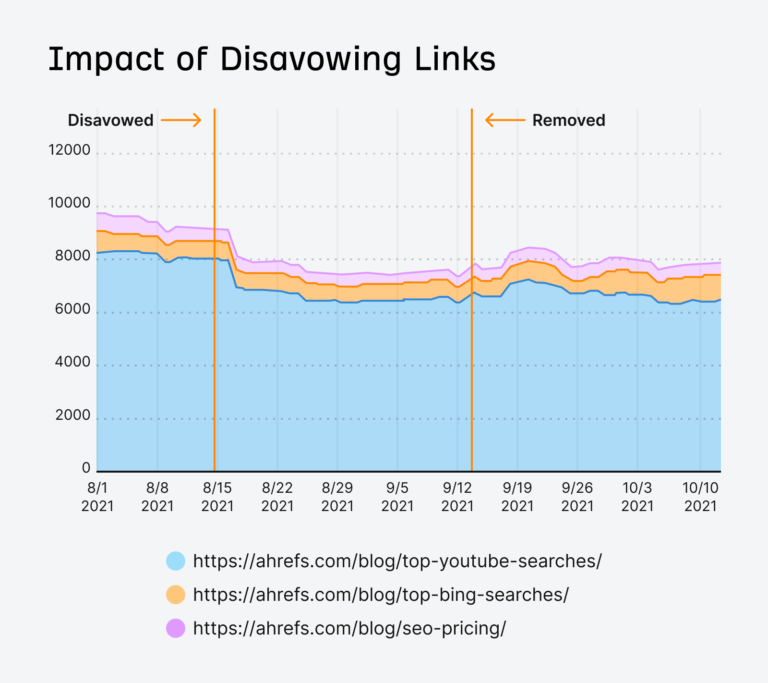
Google Says “Links Matter Less”—We Looked at 1,000,000 SERPs to See if It’s True
Google has said links are less important than they used to be, and most SEOs have come to accept that as true. Our findings indicate that this is true overall, but for certain types of queries, links matter more. I still believe that links should be a part of your SEO strategy, but they shouldn’t…

What Is Domain Renewal?
Renewing your website’s lease on the Internet for another year. Your domain is your castle. It’s the name of your website, and it may be responsible for most of your sales. Domain renewal should be one of the most important tasks on your to-do list, and letting it lapse can cause so much damage. Knowing…

15 Marketing Conferences to Attend in 2025
Conferences are a great excuse to meet other marketers, learn cutting-edge tactics, and just simply hang out and make friends! Even better if it’s on your company’s dime. Here are the marketing conferences we think are worth attending in 2025. Conference When Location Affiliate Summit East Aug. 4-5 New York, USA INBOUND Sep. 3-5 San Francisco, USA…
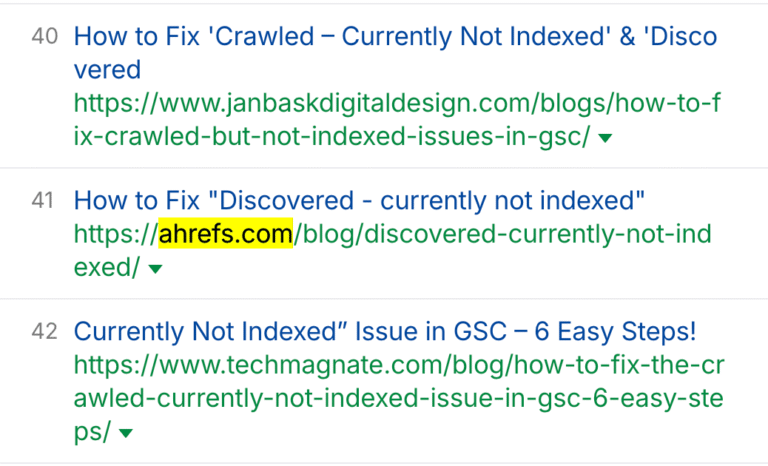
Google Thinks AI Mode Is Good for Users, but the Content Isn’t Good Enough to Rank in Google
I set up some tests over a month ago to see if Google would rank content generated by Google AI Mode in the organic search results. Spoiler: it did not rank. Google believes AI Mode content is good enough to show to users in what will likely be the default search mode in the future. But…
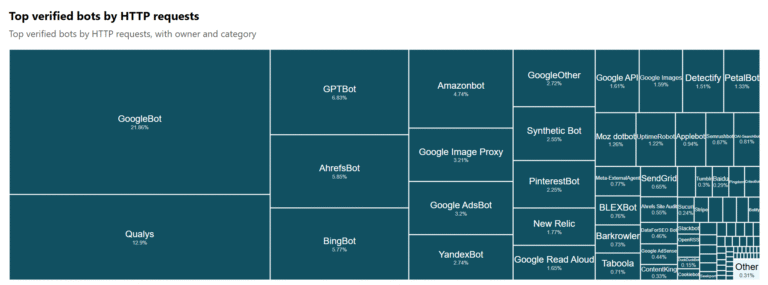
The SEO Bots That ~140 Million Websites Block the Most
Ever wonder which SEO bots are the most blocked? This can impact the quality of the data the tools provide. Blocking these bots will mostly impact the link index of the tools. They won’t be able to crawl the pages, so they can’t check where those pages are linking. It doesn’t matter for traffic estimates,…
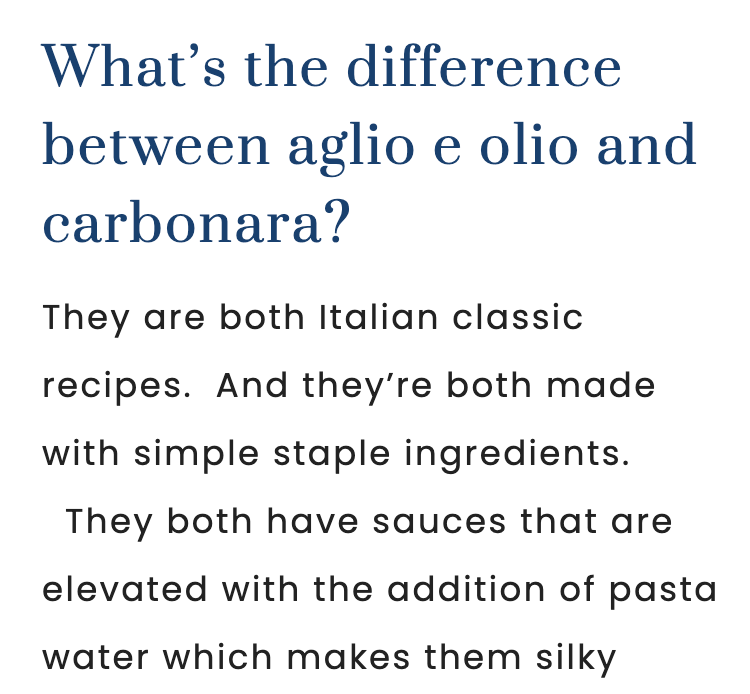
The Long-Form Content Illusion: Why Longer Content Isn’t Better
You’re looking for this article because you think long-form content works right? Or at least that’s what you’ve heard from many marketers. You might even have seen it for yourself. You’re trying to make a simple pasta dish (like aglio e olio) but you have to scroll through a piece that’s thousands of words long,…

These will typically be competitors you’re aware of and that you compete with for brand mentions in AI responses.
If you check out the Search queries report, you’ll be able to find the competitors that your audience frequently compares you to. You can filter the data by looking for queries that contain your brand and words with comparative intent, like “vs”:

For example, Honda is a strong competitor of Toyota’s that searchers frequently compare:

Other brands that are commonly compared to Toyota include Nissan, Mazda, Ford, Lexus, Suzuki, and Subaru:

To find competitors that are cited as sources, check out the Cited domains report.
More often than not, you’ll see general sites like Wikipedia, Reddit, or social media in the top spots. These sites are too large and authoritative to compare against in most cases.
But you’ll also spot other sites in your industry that get cited more than your brand. Sometimes they’ll be industry publications. Other times, they’ll be direct competitors, like Ford, Nissan, and Honda, in the example below:

Select the ones that make the most sense for your analysis or that your stakeholders care about the most.
AI Content Helper can help with this. It analyzes your content as you type, allowing you to cover essential gaps.

strong factor that influences visibility in AI responses.

More often than not, AI will cite someone else’s content (even for queries about your brand) than yours.
So, it’s worth checking which sources influence information about your brand and competitors. In Brand Radar, you can check out the Web pages report to find all mentions of any brand online.

To find gaps in web mentions, I like to search each competitor individually in the main search bar.

Then I use the filters in the Web pages report to remove mentions on their own websites and then export the results.

For instance, you can use “-site:yourcompetitor.com” to remove a competitor’s brand mentions on their own website.
Once you’ve removed irrelevant results, export the list so you can compare it against your brand and other competitors in a spreadsheet. Try out this simple template. Add your exported data to columns B–H, ensuring they are aligned correctly. Then manually fill in the brand in column A.
Keep adding each brand’s export to the bottom of the list.
Once you’ve added data for a few brands, here’s what the comparison view will look like:

The empty cells point to missed opportunities. Start by scanning for posts or responses that highlight several competitors but leave your brand out; these are likely your fastest wins.
Next, analyze how your competitors earned their most impactful mentions:
- Content types: Are their mentions embedded in blog posts, research reports, or case studies? These formats might be worth replicating or targeting in your outreach efforts.
- Publications and sources: Are the same authors or websites referencing them consistently? If so, they may be trusted voices in your space and suitable candidates for outreach or collaboration.
- Campaign triggers: Was the mention associated with a product release, viral post, or a unique framework? Identify what sparked the attention to guide your own strategic moves.
- Distribution tactics: Guest articles, joint content, or partner campaigns might be amplifying their presence.
Reverse engineering what’s working for your competitors helps you close visibility gaps, understand which tactics actually move the needle in your category, and how to make them work for your brand.
AI Search Competitor Analysis Report template if you don’t already have one.
Replace all the pink sections and summarize your key findings in scorecards and quick snapshots of key points.

Also, it’s worth making competitor tracking a recurring workflow.
Run the same analysis monthly or quarterly to measure how share of voice and brand framing evolve across AI models and markets.
AI search changes fast, and regular benchmarking turns your one-off study into an ongoing strategic advantage.
Final thoughts
An AI search competitor analysis goes beyond measuring who’s winning visibility by explaining why they’re winning.
By combining quantitative data (mentions, citations, impressions, share of voice) with qualitative context (framing, sentiment, credibility), you can pinpoint the levers that influence AI perception for your brand compared with competitors.
Over time, these insights help you refine positioning, content strategy, and digital PR, not just for Google, but for every AI system interpreting your brand.
Further reading
Similar Posts

Google Says “Links Matter Less”—We Looked at 1,000,000 SERPs to See if It’s True
Google has said links are less important than they used to be, and most SEOs have come to accept that as true. Our findings indicate that this is true overall, but for certain types of queries, links matter more. I still believe that links should be a part of your SEO strategy, but they shouldn’t…

What Is Domain Renewal?
Renewing your website’s lease on the Internet for another year. Your domain is your castle. It’s the name of your website, and it may be responsible for most of your sales. Domain renewal should be one of the most important tasks on your to-do list, and letting it lapse can cause so much damage. Knowing…

15 Marketing Conferences to Attend in 2025
Conferences are a great excuse to meet other marketers, learn cutting-edge tactics, and just simply hang out and make friends! Even better if it’s on your company’s dime. Here are the marketing conferences we think are worth attending in 2025. Conference When Location Affiliate Summit East Aug. 4-5 New York, USA INBOUND Sep. 3-5 San Francisco, USA…

Google Thinks AI Mode Is Good for Users, but the Content Isn’t Good Enough to Rank in Google
I set up some tests over a month ago to see if Google would rank content generated by Google AI Mode in the organic search results. Spoiler: it did not rank. Google believes AI Mode content is good enough to show to users in what will likely be the default search mode in the future. But…

The SEO Bots That ~140 Million Websites Block the Most
Ever wonder which SEO bots are the most blocked? This can impact the quality of the data the tools provide. Blocking these bots will mostly impact the link index of the tools. They won’t be able to crawl the pages, so they can’t check where those pages are linking. It doesn’t matter for traffic estimates,…

The Long-Form Content Illusion: Why Longer Content Isn’t Better
You’re looking for this article because you think long-form content works right? Or at least that’s what you’ve heard from many marketers. You might even have seen it for yourself. You’re trying to make a simple pasta dish (like aglio e olio) but you have to scroll through a piece that’s thousands of words long,…

strong factor that influences visibility in AI responses.

More often than not, AI will cite someone else’s content (even for queries about your brand) than yours.
So, it’s worth checking which sources influence information about your brand and competitors. In Brand Radar, you can check out the Web pages report to find all mentions of any brand online.

To find gaps in web mentions, I like to search each competitor individually in the main search bar.

Then I use the filters in the Web pages report to remove mentions on their own websites and then export the results.

For instance, you can use “-site:yourcompetitor.com” to remove a competitor’s brand mentions on their own website.
Once you’ve removed irrelevant results, export the list so you can compare it against your brand and other competitors in a spreadsheet. Try out this simple template. Add your exported data to columns B–H, ensuring they are aligned correctly. Then manually fill in the brand in column A.
Keep adding each brand’s export to the bottom of the list.
Once you’ve added data for a few brands, here’s what the comparison view will look like:

The empty cells point to missed opportunities. Start by scanning for posts or responses that highlight several competitors but leave your brand out; these are likely your fastest wins.
Next, analyze how your competitors earned their most impactful mentions:
- Content types: Are their mentions embedded in blog posts, research reports, or case studies? These formats might be worth replicating or targeting in your outreach efforts.
- Publications and sources: Are the same authors or websites referencing them consistently? If so, they may be trusted voices in your space and suitable candidates for outreach or collaboration.
- Campaign triggers: Was the mention associated with a product release, viral post, or a unique framework? Identify what sparked the attention to guide your own strategic moves.
- Distribution tactics: Guest articles, joint content, or partner campaigns might be amplifying their presence.
Reverse engineering what’s working for your competitors helps you close visibility gaps, understand which tactics actually move the needle in your category, and how to make them work for your brand.
AI Search Competitor Analysis Report template if you don’t already have one.
Replace all the pink sections and summarize your key findings in scorecards and quick snapshots of key points.

Also, it’s worth making competitor tracking a recurring workflow.
Run the same analysis monthly or quarterly to measure how share of voice and brand framing evolve across AI models and markets.
AI search changes fast, and regular benchmarking turns your one-off study into an ongoing strategic advantage.
Final thoughts
An AI search competitor analysis goes beyond measuring who’s winning visibility by explaining why they’re winning.
By combining quantitative data (mentions, citations, impressions, share of voice) with qualitative context (framing, sentiment, credibility), you can pinpoint the levers that influence AI perception for your brand compared with competitors.
Over time, these insights help you refine positioning, content strategy, and digital PR, not just for Google, but for every AI system interpreting your brand.
Further reading
Similar Posts

Google Says “Links Matter Less”—We Looked at 1,000,000 SERPs to See if It’s True
Google has said links are less important than they used to be, and most SEOs have come to accept that as true. Our findings indicate that this is true overall, but for certain types of queries, links matter more. I still believe that links should be a part of your SEO strategy, but they shouldn’t…

What Is Domain Renewal?
Renewing your website’s lease on the Internet for another year. Your domain is your castle. It’s the name of your website, and it may be responsible for most of your sales. Domain renewal should be one of the most important tasks on your to-do list, and letting it lapse can cause so much damage. Knowing…

15 Marketing Conferences to Attend in 2025
Conferences are a great excuse to meet other marketers, learn cutting-edge tactics, and just simply hang out and make friends! Even better if it’s on your company’s dime. Here are the marketing conferences we think are worth attending in 2025. Conference When Location Affiliate Summit East Aug. 4-5 New York, USA INBOUND Sep. 3-5 San Francisco, USA…

Google Thinks AI Mode Is Good for Users, but the Content Isn’t Good Enough to Rank in Google
I set up some tests over a month ago to see if Google would rank content generated by Google AI Mode in the organic search results. Spoiler: it did not rank. Google believes AI Mode content is good enough to show to users in what will likely be the default search mode in the future. But…

The SEO Bots That ~140 Million Websites Block the Most
Ever wonder which SEO bots are the most blocked? This can impact the quality of the data the tools provide. Blocking these bots will mostly impact the link index of the tools. They won’t be able to crawl the pages, so they can’t check where those pages are linking. It doesn’t matter for traffic estimates,…

The Long-Form Content Illusion: Why Longer Content Isn’t Better
You’re looking for this article because you think long-form content works right? Or at least that’s what you’ve heard from many marketers. You might even have seen it for yourself. You’re trying to make a simple pasta dish (like aglio e olio) but you have to scroll through a piece that’s thousands of words long,…

More often than not, AI will cite someone else’s content (even for queries about your brand) than yours.
So, it’s worth checking which sources influence information about your brand and competitors. In Brand Radar, you can check out the Web pages report to find all mentions of any brand online.

To find gaps in web mentions, I like to search each competitor individually in the main search bar.

Then I use the filters in the Web pages report to remove mentions on their own websites and then export the results.

For instance, you can use “-site:yourcompetitor.com” to remove a competitor’s brand mentions on their own website.
Once you’ve removed irrelevant results, export the list so you can compare it against your brand and other competitors in a spreadsheet. Try out this simple template. Add your exported data to columns B–H, ensuring they are aligned correctly. Then manually fill in the brand in column A.
Keep adding each brand’s export to the bottom of the list.
Once you’ve added data for a few brands, here’s what the comparison view will look like:

The empty cells point to missed opportunities. Start by scanning for posts or responses that highlight several competitors but leave your brand out; these are likely your fastest wins.
Next, analyze how your competitors earned their most impactful mentions:
- Content types: Are their mentions embedded in blog posts, research reports, or case studies? These formats might be worth replicating or targeting in your outreach efforts.
- Publications and sources: Are the same authors or websites referencing them consistently? If so, they may be trusted voices in your space and suitable candidates for outreach or collaboration.
- Campaign triggers: Was the mention associated with a product release, viral post, or a unique framework? Identify what sparked the attention to guide your own strategic moves.
- Distribution tactics: Guest articles, joint content, or partner campaigns might be amplifying their presence.
Reverse engineering what’s working for your competitors helps you close visibility gaps, understand which tactics actually move the needle in your category, and how to make them work for your brand.
AI Search Competitor Analysis Report template if you don’t already have one.
Replace all the pink sections and summarize your key findings in scorecards and quick snapshots of key points.

Also, it’s worth making competitor tracking a recurring workflow.
Run the same analysis monthly or quarterly to measure how share of voice and brand framing evolve across AI models and markets.
AI search changes fast, and regular benchmarking turns your one-off study into an ongoing strategic advantage.
Final thoughts
An AI search competitor analysis goes beyond measuring who’s winning visibility by explaining why they’re winning.
By combining quantitative data (mentions, citations, impressions, share of voice) with qualitative context (framing, sentiment, credibility), you can pinpoint the levers that influence AI perception for your brand compared with competitors.
Over time, these insights help you refine positioning, content strategy, and digital PR, not just for Google, but for every AI system interpreting your brand.
Further reading
Replace all the pink sections and summarize your key findings in scorecards and quick snapshots of key points.

Also, it’s worth making competitor tracking a recurring workflow.
Run the same analysis monthly or quarterly to measure how share of voice and brand framing evolve across AI models and markets.
AI search changes fast, and regular benchmarking turns your one-off study into an ongoing strategic advantage.
Final thoughts
An AI search competitor analysis goes beyond measuring who’s winning visibility by explaining why they’re winning.
By combining quantitative data (mentions, citations, impressions, share of voice) with qualitative context (framing, sentiment, credibility), you can pinpoint the levers that influence AI perception for your brand compared with competitors.
Over time, these insights help you refine positioning, content strategy, and digital PR, not just for Google, but for every AI system interpreting your brand.
Further reading
Similar Posts

Google Says “Links Matter Less”—We Looked at 1,000,000 SERPs to See if It’s True
Google has said links are less important than they used to be, and most SEOs have come to accept that as true. Our findings indicate that this is true overall, but for certain types of queries, links matter more. I still believe that links should be a part of your SEO strategy, but they shouldn’t…

What Is Domain Renewal?
Renewing your website’s lease on the Internet for another year. Your domain is your castle. It’s the name of your website, and it may be responsible for most of your sales. Domain renewal should be one of the most important tasks on your to-do list, and letting it lapse can cause so much damage. Knowing…

15 Marketing Conferences to Attend in 2025
Conferences are a great excuse to meet other marketers, learn cutting-edge tactics, and just simply hang out and make friends! Even better if it’s on your company’s dime. Here are the marketing conferences we think are worth attending in 2025. Conference When Location Affiliate Summit East Aug. 4-5 New York, USA INBOUND Sep. 3-5 San Francisco, USA…

Google Thinks AI Mode Is Good for Users, but the Content Isn’t Good Enough to Rank in Google
I set up some tests over a month ago to see if Google would rank content generated by Google AI Mode in the organic search results. Spoiler: it did not rank. Google believes AI Mode content is good enough to show to users in what will likely be the default search mode in the future. But…

The SEO Bots That ~140 Million Websites Block the Most
Ever wonder which SEO bots are the most blocked? This can impact the quality of the data the tools provide. Blocking these bots will mostly impact the link index of the tools. They won’t be able to crawl the pages, so they can’t check where those pages are linking. It doesn’t matter for traffic estimates,…

The Long-Form Content Illusion: Why Longer Content Isn’t Better
You’re looking for this article because you think long-form content works right? Or at least that’s what you’ve heard from many marketers. You might even have seen it for yourself. You’re trying to make a simple pasta dish (like aglio e olio) but you have to scroll through a piece that’s thousands of words long,…

